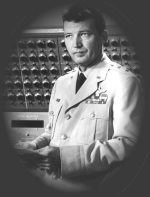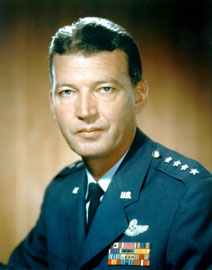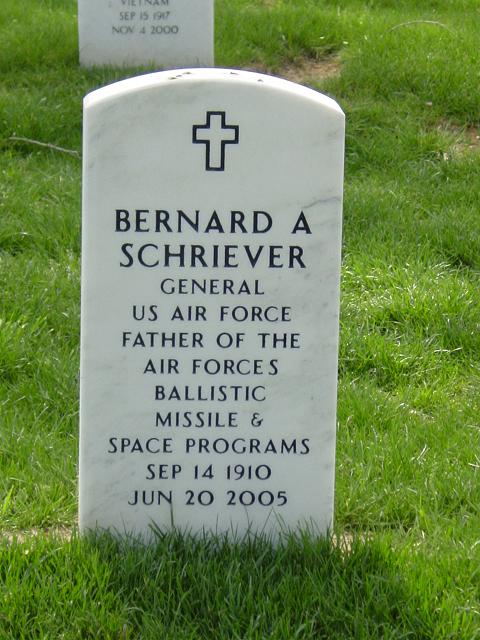Courtesy of the United States Air Force:
GENERAL BERNARD A. SCHRIEVER
Retired August 31, 1966
Bernard Adolph Schriever, who was commander of Air Force Systems Command, was born in Bremen, Germany, in 1910. The architect of the Air Force’s ballistic missile and military space program, he came to America in 1917 when his parents emigrated from Germany. He became a naturalized citizen in 1923, attended grade and high school at San Antonio, Texas, and graduated from Texas A&M in 1931 with a bachelor of science degree.
He was commissioned in the Field Artillery but in July 1932 began flight training at Randolph Field and earned his wings and commission in the Air Corps in June 1933 at Kelly Field. He was assigned as a bomber pilot at March and Hamilton fields, California, with promotion in June 1933 to First Lieutenant.
He went to Panama for duty at Albrook Field and in September 1937 left the Air Corps to fly as a pilot with Northwest Airlines. He returned to duty in October 1938 with the 7th Bomb Group at Hamilton and a year later became a test pilot at Wright Field, where he also attended the Air Corps Engineering School, graduating in July 1941. He then took an advanced course in aeronautical engineering at Stanford University, was promoted to captain in April 1942, and got his master’s degree in June as a newly promoted Major.
In July Schriever went to the Pacific for combat with the 19th Bomb Group, taking part in the Bismarck Archipelago, Leyte, Luzon, Papua, North Solomon, South Philippine and Ryukyu campaigns. In January 1943 he moved to the 5th Air Force Service Command in maintenance and engineering assignments, and as chief of staff, finally becoming commanding officer of advanced headquarters for the Far East Air Service Command which supported theater operations from bases in Hollandia, New Guinea, Leyte, Manila and Okinawa.
He was promoted to Lieutenant Colonel in August 1943 and to Colonel that December. After the war Schriever went to Headquarters Army Air Forces as chief of scientific liaison in materiel for three and a half years. He graduated from the National War College in June 1950 and returned to Headquarters Army Air Forces as assistant for evaluation, in development. In January 1951 he continued the same type of work with the title of assistant for development planning and was promoted to Brigadier General in June 1953.
Schriever began his long association with ARDC – now AFSC – in June 1954 as assistant to the commander. The next month he headed a small group of officers who went to Los Angeles to organize and form what has since become the Air Force’s ballistic and systems divisions under AFSC with the end product such ballistic missiles as Thor, Atlas, Titan and Minuteman, and all the aerospace systems which have been launched into orbit, including support for NASA in its Mercury man-in-space and other programs.
Schriever was promoted to two-star rank in December 1955. He left Los Angeles for Andrews Air Force Base, Maryland, in April 1959 as commander of ARDC, which became AFSC April 1, 1961, under a reorganization initiated by him. He was promoted to Lieutenant General on that date, April 25, 1959, and to full General on July 1, 1961.
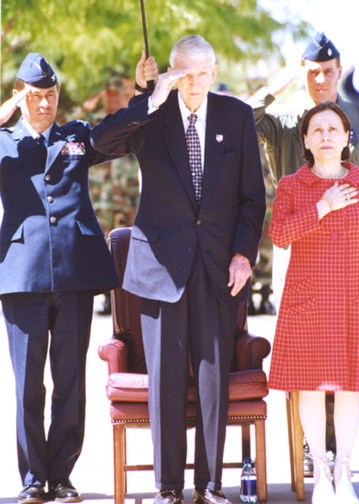
Bernard Schriever Dies; General Led Missile Development
By Louie Estrada
Courtesy of the Washington Post
Thursday, June 23, 2005
Bernard A. Schriever, 94, a retired Air Force General who became a revered military figure for successfully shepherding the development of the intercontinental ballistic missile program and establishing a framework for the Air Force’s space program, died June 20, 2005, of complications from pneumonia at his home in Washington, D.C.
General Schriever, an aeronautical engineer by training, excelled as an administrator, supervisor and manager as he helped to restructure and streamline the Air Force’s approach to research, development and production of its high-tech weaponry in the 1950s and ’60s. Chief among those weapons was the intercontinental ballistic missile, which could deliver a nuclear warhead halfway around the world.
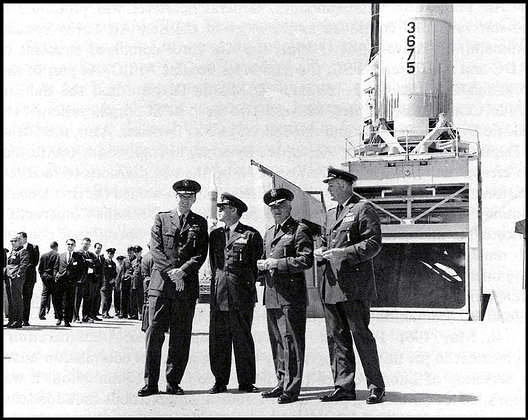
He oversaw the development of the missile beginning in 1954, when he was named the first commander of what was then the Air Force Air Research and Development Command’s Western Development Division in Inglewood, Calif. Known for his ingenuity and forthrightness, he took the post only after being assured by superiors that he would be granted wide latitude in cutting through the bureaucratic regulations and archaic review and approval procedures.
At the time, the development of the missile had been given the highest priority in the United States as its Cold War adversary, the Soviet Union, was busy developing its own long-range ballistic missiles. General Schriever, a firm believer in a strong defense as a deterrent, set a goal of producing such a missile by the end of the 1950s. His office also was given the responsibility of developing the powerful missiles, which could travel as much as 5,000 miles, to launch the military’s communication satellites.
His first step as commander was to assemble a staff with a core group of loyal workers who embraced a management technique called “concurrency.” The technique sought to consolidate the management process by encouraging civilian contractors, lab commanders, technical chiefs and their groups to each tackle a technical or engineering problem simultaneously with the best solution selected from among the teams.
What followed was the expedited production of the Thor intermediate range ballistic missile and the Atlas and Titan intercontinental ballistic missile series in the 1950s. Next came the solid propellant Minuteman intercontinental ballistic missile.
General Schriever, who served as the Pentagon’s liaison to the scientific community earlier in his career, was “known as a man with complete integrity and sound judgment, neither rebel nor a nonconformist,” wrote aerospace historian G. Harry Stine in his book “ICBM, the Making of the Weapon that Changed the World” (1991). “Furthermore, he could stimulate action and get things done. And he had a rare understanding of the intricacies and internal politics of the aerospace industry.”
In 1959, General Schriever was named commander of the Air Research and Development Command, and in 1961, he became commander of the Air Force Systems Command. He consolidated research and development divisions and gave division directors greater control over their technical programs and budgets.
In 1963, he directed Project Forecast, one of the most comprehensive long-range assessments of the military science and technology. The multivolume report was based on a large gathering of specialists from federal agencies, universities, corporations and nonprofit organizations.
General Schriever retired in 1966 after 33 years in the military. He continued to serve in advisory roles for corporate and government clients.
During his career, he recognized the significance of the intellectual capacity of his staff and said that same mental prowess would be needed to usher the United States into the space age. He once wrote that it was “a national disgrace the term ‘egghead’ as synonym for intellectual excellence has become a derogatory expression.”
“Let me tell you that it is the ‘eggheads’ who are saving us — just as it was the ‘eggheads’ who wrote the Constitution of the United States. It is the ‘eggheads’ in the realm of science and technology, in industry, in statecraft, as well as in other fields who form the first line of freedom’s defense.”
General Schriever was born in Bremen, Germany, where his father served in the merchant marine. In 1917, his family came to the United States and settled in New Braunfels, Texas, a German-American community, about 30 miles north of San Antonio. He became a naturalized citizen when he was about 13 years old. As a young man, he considered pursuing golf as a profession.
He joined the Army after graduating from Texas A&M University in 1931 with a degree in architectural engineering. An ROTC cadet in college, he received a commission in the Army’s Field Artillery but a short time later enrolled in the Army Air Corps Flying School at Kelly Field, Texas.
He flew air-mail missions for the Army Air Corps and received a master’s degree in aeronautical engineering in 1942 from Stanford University.
During World War II, he helped maintain Army Air Forces planes and flew combat missions as a B-17 pilot in the Pacific.
He received the Air Force Space and Missile Pioneers Award and the Air Force Institute of Technology Distinguished Graduate Award. In 1998, Falcon Air Force Base near Colorado Springs was renamed Schriever Air Force Base.
His marriage to Dora Brett Schriever ended in divorce.
Survivors include his wife, singer Joni James of Washington; three children from his first marriage, son Brett Schriever of Colorado Springs and daughters Dodie Moeller of Stevensville, Maryland, and Barbara Allan of Washington; a brother; and 11 grandchildren.
General Schriever will be buried with full military honors in Arlington National Cemetery on 12 July 2005.
SCHRIEVER, SIR GENERAL BERNARD A.
U.S.A.F (Ret.), K.H.S.On June 20, 2005, SIR GENERAL BERNARD A. SCHRIEVER of Washington, D.C.
Beloved husband of Joni James Schriever; devoted father of Colonel Brett Schriever, USAF (Retired) of Colorado Springs, Colorado; Dodie Schriever Moeller of Stevensville, Maryland and her husband, Colonel Ted Moeller, USAF (Retired) and Barbara Schriever Allan and her husband, William Allan of Washington, D.C. Dear stepfather of Michelangelo Acquaviva of Joppa, Alabama, and Angela Mia Acquaviva Kwoka of Melbourne, Florida. He is also survived by 11 grandchildren and seven great-grandchildren.
Relatives and friends are invited to call at St. Matthew’s Cathedral, 1725 Rhode Island Ave., NW, Washington, D.C. 20036 on Monday, July 11, 2005 from 1 to 3 p.m., where Mass of Christian Burial will be celebrated at 3 p.m. Additional services will be held at Fort Myer Chapel, Arlington, Virginia, on Tuesday, July 12, 2005 at 9:30 a.m., followed by interment with Full Military Honors at Arlington National Cemetery. A reception at the Ft. Myer’s Officer’s Club will follow.
In lieu of flowers, memorial contributions may be made in his name to the Air Force Association, Aerospace Education Foundation, 1501 Lee Hwy., Arlington, Virginia 22209-1198 or the Air Force Historical Foundation, 1535 Command Dr., Suite A122, Andrews Air Force Base, Maryland 20762 or the Air Force Memorial Foundation, 1501 Lee Hwy., Arlington, Virginia 22209-1198 or to the charity of your choice.
July 15, 2005
A FINAL SALUTE
BOLLING PARTICIPATES IN HISTORIC FUNERAL
by 2nd Lt. Landon Derentz
BEAM staff, 11th Wing Public Affairs
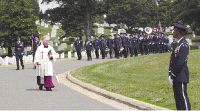
Members of the 11th Wing participated in retired General Bernard A. Schriever’s funeral Tuesday morning at Arlington National Cemetery, commemorating the life of the space pioneer.
The U.S. Air Force Band and U.S. Air Force Honor Guard were on hand during the ceremony.
The Air Force Band Ceremonial Brass, led by Conductor Captain Matthew Reese and Drum Major Senior Master Sergeant Albert Islas, performed “Four Ruffles and Flourishes,” “Generals March” and multiple hymns including “Faith of our Fathers” and “Battle Hymn of the Republic” during the ceremony.
A Band bugler, Master Sergeant, Michael Busch, played taps to honor General Schriever.
Honor Guard pallbearers were active throughout the ceremony, reverently carrying the casket to and from the Fort Myer Memorial Chapel and finally to the graveside, only a few gravestones away from another famous Air Force pioneer, General Henry H. “Hap” Arnold.
The Honor Guard also provided a firing party that fired three, seven-rifle volleys, rendering full military honors along with a four-man color team and two flights of Honor Guardsmen to march in the funeral procession.
“The service was significant because it represented the past and the present,” said Captain Monique C. Okorie, the deputy director of 11th Wing Ceremonies and Protocol.
“Our nation’s top military leadership honored the founding father of the space age,” she said.
Several military leaders were on hand for the funeral, including Secretary of Defense Donald H. Rumsfeld, Chairman of the Joint Chiefs of Staff General Richard B. Myers and Air Force Chief of Staff General John P. Jumper.
Born in Germany in 1910, General Schriever was a pioneer in Air Resource and Development Command — today know as Air Force Space Command. He is considered the architect of the Air Force’s ballistic missile and military space program. General Schriever retired August 31, 1966 and passed away June 20, 2005.
SCHRIEVER, BERNARD A
GEN US AIR FORCE
WORLD WAR II
- DATE OF BIRTH: 09/14/1910
- DATE OF DEATH: 06/20/2005
- BURIED AT: SECTION 34 SITE 162
ARLINGTON NATIONAL CEMETERY
Michael Robert Patterson was born in Arlington and is the son of a former officer of the US Army. So it was no wonder that sooner or later his interests drew him to American history and especially to American military history. Many of his articles can be found on renowned portals like the New York Times, Washingtonpost or Wikipedia.
Reviewed by: Michael Howard

